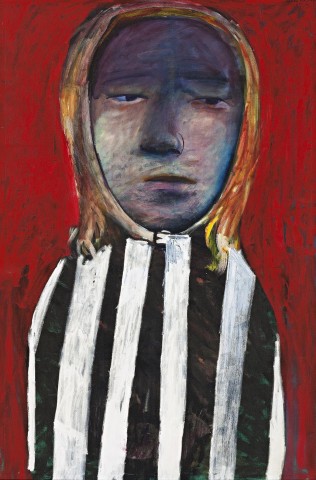THE BARRACKER, 1965
CHARLES BLACKMAN
oil on canvas
137.5 x 91.5 cm
signed and dated upper right: CHARLES BLACKMAN / 1965
inscribed with title and date verso; indistinct: The Barracker 8 2 65
bears label with date and title verso: THE BARRACKER / 1965 / Charles Blackman
Zwemmer Gallery, London
Private collection
Christie’s, Sydney, 5 October 1971, lot 277
Private collection, Sydney
Charles Blackman, Zwemmer Gallery, London, 14 September – 9 October 1965, cat. 11
In 1960s’ Australia, Australian Rules football was viewed by the rest of the country as being some strange tribal phenomenon largely confined to Victoria, snootily dismissed as being ‘aerial ping-pong’. How times have changed, but until the 1990s, AFL’s parochialism was its strength. Even overseas, expatriate tribalism existed as evidenced by The Barracker, 1965, a marvellous study of a disconsolate Collingwood supporter painted by Charles Blackman in London, and exhibited there before that year’s Preliminary Final. The city at that time was the home to numerous Australian artists, performers and writers, and the Blackmans’ apartment in Regent’s Park became a central hub for many of them where, no doubt, the fortunes of their chosen teams were passionately discussed. The creation of The Barracker proved to be sadly prescient for back in Melbourne, on the other side of the world, the Magpies lost that match against their arch-foes, Essendon’s Bombers.
England is home to the ‘gentleman’s’ game of Rugby Union and locals must have been puzzled by any attempt to describe the Australian game. That said, given their own levels of sports fanaticism, the emotions signalled by The Barracker would have been immediately recognisable. Blackman had arrived in London with his family in early January 1961, experiencing rapid popularity through his inclusion in the significant exhibition Recent Australian Painting held at the prestigious Whitechapel Gallery in June of that year. This was followed by the outstanding commercial success of his solo show at the Mathieson Gallery in November. Like Australian audiences, the British were drawn to the implicit poetry of Blackman’s paintings, the shaded, averted eyes, imploring hands and tactile surfaces. His were figures, often monumental, whose inner lives could only be guessed at, and which struck a deep note of recognition within viewers. Like The Barracker, they were also exquisitely painted in a combination of direct naïf style allied with a mature, instinctive handling of paint, all underscored by Blackman’s significant drawing skills.
Given the stature of sport in Australia, it is remarkable how few have attempted to depict it. In an incisive essay, the noted academic (and football tragic) Dr Chris McAuliffe identifies only isolated works by artists including Arthur Streeton, Margaret Preston, John Brack and Ian Abdullah, as well as a small group of portrait studies by Fred Williams of Collingwood players dating from 1947.1 Perhaps the strongest companion to The Barracker is Sidney Nolan’s Full back, St Kilda, c.1946 (National Gallery of Victoria, Melbourne), an equally large and boldly painted vision of an AFL team member. Blackman, however, has turned his gaze from the field to focus instead on the endurance of a committed punter. In 1965, Collingwood was already amidst an extended period of premiership loss. Having last been triumphant in 1958 against Melbourne, it would be another thirty-two years before they won again (against Essendon!) in 1990. These days, of course, the jersey would be St. Kilda’s, a team whose sole Grand Final victory was way back in 1966. Its wearer, most likely, would be their most prominent supporter, Ian ‘Molly’ Meldrum, but no matter the personality, in those repeated moments of defeat, triumph, despair and private reflection, Charles Blackman’s The Barracker captures the personalised experience of any devoted football fan.
1. See McAuliffe, C., ‘Eyes on the ball: images of Australian Rules football, 1995’
[https://chrismcauliffe.com.au/eyes-on-the-ball-images-of-australian-rule...
(accessed 14/10/19). In 2004, the noted collector Basil Sellers instigated a high-profile prize for artists depicting sports, which ran biennially for ten years.
ANDREW GAYNOR
